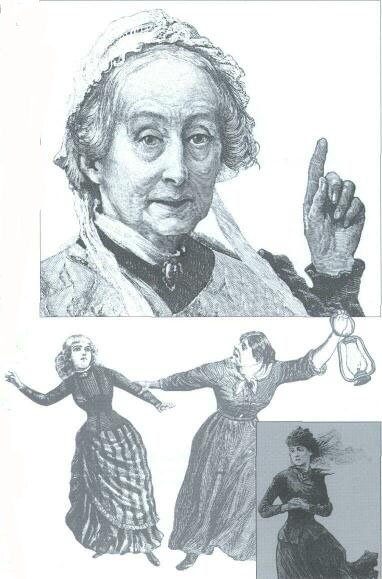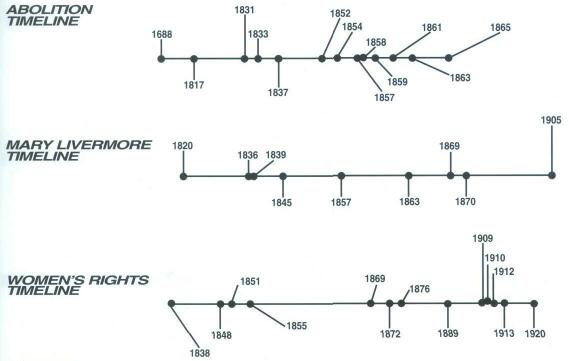 |
Home | Search | Browse | About IPO | Staff | Links |
 |
Home | Search | Browse | About IPO | Staff | Links |
|
Main Ideas
Connection with the Curriculum
Teaching Level
Materials for Each Student
• A copy of this article's content portion
Objectives for Each Student
• Understand the chronology of important events in both the abolition and the women's rights movement. • Demonstrate an understanding of Mary Livermore's contributions to both movements.
Opening the Lesson
Developing the Lesson
• Activity 1 is to be used as a means of
assessing the reading of the article.
Distribute Activity 1 after the completion
of the reading. Students may work individually or in groups to discover the
ten historical errors within the "document."
• Activity 2 is designed to introduce
the students to those people involved
in the abolition and the women's rights
movements. Divide the class into
groups and provide reference materials
to the students.
• Activity 3 is designed to illustrate chronological thinking in history. Again, students will need additional reference material to complete the task. First, distribute Activity 3, Part 1. Using the reference materials, students will uncover the dates for each event listed. Once that is completed, distribute 6
Part 2 and students will fit each event
into the appropriate position on one of
the three timelines. • Activity 4 is designed as an alternative assessment of the material. In 1863, Mary Livermore organized the Great Northwestern Sanitary Commission Fair in order to raise money for the work the commission did on behalf of the Union soldiers. Students will demonstrate an understanding of Mary Livermore's life and contributions in abolition and the Civil War by writing a letter to Abraham Lincoln asking for assistance in the upcoming fair. In this letter, they are to pretend that they are Mary Livermore. In it, they should discuss her reasons for the letter, objectives, and her prior contributions to abolition and the war. After completion of this letter, students will write another letter—a response from Abraham Lincoln. Each letter should be dated correctly and contain the appropriate historical information.
Concluding the Lesson
• Write a resume for Mary Livermore • Write an obituary for Mary Livermore Discuss Mary Livermore's role in the abolition and women's rights movements with the class. Then, have the students check their own textbooks to see what is said about her. Why is she not discussed more in the textbooks? Discuss the qualities that an individual needs in order to "make a stand." Does Mary Livermore fit the description? What would Mary Livermore say about the present state of women in America? Would she be pleased? Would she recognize the work that still needs to be done?
Extending the Lesson
• Distribute a copy of the "Declaration of Sentiments." Compare it with the Declaration of Independence. • For upper level students, find and distribute a copy of Mary Livermore's lecture, "What Shall We Do With Our Daughters?" Discuss the similarities and differences between how women were viewed in the nineteenth century and today.
Assessing the Lesson

7
A fraud has been uncovered. Below is a transcription of a recently uncovered letter. It is supposed to have been written by Mary Livermore. However, it contains numerous historical errors—ten to be exact. Can you find them?
Outcomes
March 19, 1908
My Dearest Jane: Well, we did it. The 19th Amendment passed today! We finally have the right to vote! It has been a long and tumultuous journey, hasn't it? Remember so long ago when we worked first for the emancipation of the slaves? Oh, those were the days. Little did we know the troubles we would have. I can never forget teaching those children down in Georgia and seeing the cruelties of slavery. Once in Chicago, it all seemed so clear: slavery must end. Too bad it had to end with the spilling of blood. Remember working for the Red Cross? All those hours struggling to provide for our troops. The Fair we sponsored in 1865 was a success and even Abraham Lincoln donated a copy of his Gettysburg Address. We raised over $1,000,000. But, as you know, the treatment of women did not improve, even though we were instrumental in the Confederate victory. Therefore, we organized the Suffrage Convention in 1875. What a success that was! People from all over the country came to our cause! Elizabeth Cady Stanton, Myra Bradwell, Susan B. Anthony—what a parade of formidable women. I felt honored to work among them when I began editing The Liberator in 1870. And here we are, thirty-eight years later with our objective completed. But, I must say, my dear Jane, we still have a long way to go. Take care, my friend. See you in a few weeks.
Sincerely,
Mary Ashton Rice Livermore 8
Focus
Outcomes
DIRECTIONS: Match the people with the descriptions below
_______1. I knew Mary since her early days in the abolition movement. I published the anti-slavery newspaper, The Liberator, and shared in Mary's vision for women's suffrage. ________2. I was the lifelong friend of Mary. We both worked for the Northwestern Sanitary Commission and saw the horrors of war firsthand when we visited military hospitals. _______3. I was a coworker with Mary in the Sanitary Commission. I later went on to found the American Red Cross. ________ 4. I was cofounder of the American Woman Suffrage Association and made headlines for refusing to take my husband's last name. In addition, I worked with Mary on The Woman's Journal. In 1872, I assumed responsibility of editor. _______5. I associated with Mary during the war and met with her several times to discuss conditions in the military hospitals. I also strove for prison reform and to better the conditions in insane asylums. ________6. I worked tirelessly to improve the level of care for soldiers in the Civil War. When in Chicago, I was fortunate that Mary would let her house become my home. I stepped on a lot of toes, and even General Sherman claimed that I "outranked" him! ________7. Mary and the women of the Sanitary Commission made such an enormous contribution to the war effort. I donated an original copy of the Emancipation Proclamation. I believe it sold for $10,000 at an auction. Anything to help our boys at the front!
9
_______ 8. Mary and I became well acquainted through our work in women's suffrage. I helped found the suffrage movement in Seneca Falls, New York, in 1848. There, I drafted the "Declaration of Sentiments." ______9. I was influenced by many people in both the abolition and the women's movements. I helped found the American Woman Suffrage Association and was arrested in 1872 for attempting to vote. I met Mary Livermore at the Chicago women's suffrage convention. _______ 10. Although I have been an outspoken member of both movements, I am probably best known for my poem, "The Battle Hymn of the Republic." I worked with Mary on several articles I submitted to Woman's Journal. ____ 11. As a Quaker preacher, I helped voice the evils of slavery. But when I was kicked out of a London antislavery meeting in 1840 because of my sex, I devoted my life to gaining suffrage for women. In 1848, I helped found the Seneca Falls Convention. _______ 12. I spoke at the Chicago women's suffrage convention at the request of Mary Livermore. I also wrote articles for The Liberator and spoke out against slavery and for women's suffrage. I was very outspoken, losing a job in 1862 for publicly criticizing General George B. McClellan. In my later years, I wrote plays and even acted on stage, I attempted to play a female Hamlet, but was hindered by merciless critics. 10
Focus
Outcomes
• You will demonstrate an understanding of the role Mary Livermore played in both the abolition and the women's rights movements. Next to each event below, write the year in which the event occurred. _____ Mary Ashton Rice marries Daniel Livermore. _____ Sarah Grimke publishes an essay, "Letter on the Equality of Sexes and Condition of Women," calling for equal treatment of women. _____ Pennsylvania Quakers issue the first antislavery statement in America. ______The Nineteenth Amendment is ratified, thus granting suffrage to women in the United States. _____ Mary Livermore moves to Chicago. _____The Illinois Woman Suffrage Association is founded. _____The Dred Scott case ends with the decision that slaves are nothing more than property. _____The Kansas-Nebraska Act gives the issue of slavery to the people of those territories. _____Mary Ashton Rice is born in Boston, Massachusetts. _____Theodore Roosevelt's Progressive Party demands that suffrage be given to women on a national level. _____The first woman suffrage parade is held in New York City. _____Harriet Beecher Stowe publishes Uncle Tom's Cabin. _____The American Anti-slavery Society is formed. _____William Lloyd Garrison publishes the influential abolition newspaper, The Liberator. _____Mary Livermore presides over the Great Northwestern Sanitary Commission Fair in Chicago.
11
_____Women of Illinois are given the right to vote in presidential elections. _____The Workman's Suffrage Party in New York City is organized by Carrie Chapman Catt. _____The National American Woman Suffrage Association is formed. _____ Mary Livermore is elected president of the Illinois Woman Suffrage Association. _____The American Colonization Society is formed. _____Abraham Lincoln states that "A house divided against itself cannot stand." _____ Mary Ashton Rice becomes a teacher. _____ Susan B. Anthony is arrested along with other women in Rochester, New York, for attempting to vote. _____ Mary Ashton Rice Livermore dies at the age of eighty-four. _____ Radical abolitionist John Brown attempts a raid of the federal arsenal at Harper's Ferry, Virginia. _____ Susan B. Anthony writes "Women's Declaration of Rights". _____ Mary Ashton Rice leaves home at the age of eighteen and teaches in the South where she is exposed to the cruelties of slavery. _____The women's suffrage movement is founded by Elizabeth Cady Stanton and Lucretia Mott in Seneca Falls, New York. "The Declaration of Sentiments" is presented at the Women's Rights Convention. _____ Mary Livermore moves to Boston in order to edit The Woman's Journal. _____ Elijah Lovejoy is killed defending his abolitionist newspaper in Alton, Illinois. _____ First shots are fired in the Civil War at Fort Sumter, South Carolina. _____Abraham Lincoln issues the Emancipation Proclamation. _____ Lucy Stone marries and keeps her maiden name. _____The Thirteenth Amendment, which abolishes slavery, is ratified. _____ Sojourner Truth attends the Woman's Rights Convention in Ohio and gives her famous "Ain't I a Woman?" speech. 12
Now, place each event in the proper location on the timeline.

Questions:
13
Click Here to return to the Article 14 |
|
|